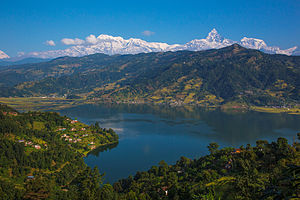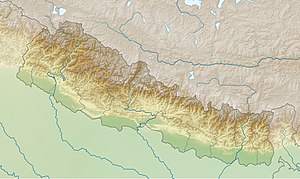Phewa Lake
Phewa Lake, Phewa Tal or Fewa Lake is a freshwater lake in Nepal located in the south of the Pokhara Valley that includes Pokhara city; parts of Sarangkot and Kaskikot. The lake is stream-fed but a dam regulates the water reserve, therefore, the lake is classified as semi-natural freshwater lake.[1] It is the second largest lake in Nepal the largest in Gandaki Zone followed by Begnas Lake.[2] It is the most popular and most visited lake of Nepal. It is the only one lake of Nepal which has temple at the centre part of lake, Natively called Barahi Mandir. Phewa lake is located at an altitude of 742 m (2,434 ft) and covers an area of about 5.23 km2 (2.0 sq mi).[3] It has an average depth of about 8.6 m (28 ft) and a maximum depth of 24 m (79 ft).[4] Maximum water capacity of the lake is approximately 43,000,000 cubic metres (35,000 acre·ft).[5] The Annapurna range on the north is only about 28 km (linear distance) away[6] from the lake. The lake is also famous for the reflection of mount Machhapuchhre and other mountain peaks of the Annapurna and Dhaulagiri ranges on its surface.[7] The Taal Barahi Temple is situated on an island in the lake.[8]Phewa Lake
फेवा ताल
Baidam Tal Reflection of the Annapurna Range on Phewa Lake
Reflection of the Annapurna Range on Phewa LakeLocation Kaski Coordinates 28°12′51″N 83°56′50″ECoordinates: 28°12′51″N 83°56′50″E Lake type Freshwater Primary inflows Harpan & Phirke Khola Catchment area 122.53 km2 (47.31 sq mi) Basin countries Nepal Max. length 4 km (2.5 mi) Max. width 2 km (1.2 mi) Surface area 5.23 km2 (2.0 sq mi) Average depth 8.6 m (28 ft) Max. depth 24 m (79 ft) Water volume 0.046 km3 (0.011 cu mi) Surface elevation 742 m (2,434 ft) Frozen Does not freeze Islands Tal Barahi (तालबाराही) Settlements Pokhara, Sarangkot, Kaskikot, Dhikurpokhari
Contents
Lake economy
Phewa lake and water sports is the main tourist attraction of Pokhara city and the north shore of the lake has developed into a tourist district, commonly called Lake-Side, with hotels, restaurants and bars catering to the tourists.[9] The water from Phewa lake's outlet is used to generate electricity. The Phewa Power House is located about 1.5 km (0.93 mi) from the southern part of the Phewa lake.[10] A part of the lake is also used as commercial caged fisheries.[11]
Major Attraction
Tal Barahi Temple lying in the center of Phewa lake, Pokhara- Tal Barahi Temple, located at the center of Phewa Lake, is the most important religious monument of Pokhara.This two-storied pagoda is believed to be dedicated one of the Hindu god known as Vishnu. Mostly it gets crowded in the Saturdays.
- Baidam is the eastern banks of Phewa lake also known as Lakeside. This part contains seemingly endless strip of hotels, lodges, restaurants, bookshops and souvenir shops. This side is one of the best known tourist area of nepal. It is also the starting point of the tour to Pokhara.[12]
- Sarankot and para gliding, Sarankot is the only one place in Nepal, for the para gliding, from where you can fly over the Fewa lake.
See also
References
- Shrestha, P; Janauer, G. A. (2001). "Management of Aquatic Macrophyte Resource: A Case of Phewa Lake, Nepal" (PDF). Environment and Agriculture: Biodiversity, Agriculture and Pollution in South Asia. Ecological Society (ECOS): 99–107.
- Aryal, Vijay (28 October – 2 November 2007). "Phewa Lake Watershed Area: A Study on the Challenges to Human Encroachment" (PDF). Proceedings of Taal 2007: The 12th World Lake Conference, Jaipur, India. International Lake Environment Committee: 2292–2299.
- Rai, Ash Kumar (2000). "Evaluation of natural food for planktivorous fish in Lakes Phewa, Begnas, and Rupa in Pokhara Valley, Nepal" (PDF). Limnology. 1: 81–89. doi:10.1007/s102010070014.
- Shrestha, Purushottam (2003). "Conservation and management of Phewa Lake ecosystem, Nepal" (PDF). Aquatic Ecosystem Health and Management Society. pp. 1–4.
- Pokharel, Shailendra (2003). "Lessons from Nepal on Developing a Strategic Plan for the Integrated Lake Basin Management: Conservation of Phewa Lake of Pokhara, Nepal" (PDF). International Lake Environment Committee: World Lake Database.
- Gulia, K. S. "Himalayan Treks in Nepal". Discovering Himalaya: Tourism of Himalayan Region. Delhi, India: Isha Books. p. 63. ISBN 81-8205-410-9.
- Giri, Bikash; Chalise, Mukesh Kumar (2008). "Seasonal Diversity and Population Status of Waterbirds in Phewa Lake, Pokhara, Nepal". Journal of Wetlands Ecology. 1 (1/2): 3–7. doi:10.3126/jowe.v1i1.1568.
- Shrestha, Nanda R. (1997). "Pot Goes Pop on Kathmandu's Freak Street". In the Name of Development: A Reflection on Nepal. Lanham, Maryland: University Press of America. p. 163. ISBN 0-7618-0758-6.
- Gurung, Tek B.; Wagle, Suresh K.; Bista, Jay D.; Dhakal, Ram P.; Joshi, Purushottam L.; Batajoo, Rabindra; Adhikari, Pushpa; Rai, Ash K. (2005). "Participatory fisheries management for livelihood improvement of fishers in Phewa Lake, Pokhara, Nepal". Himalayan Journal of Sciences. 3 (5). ISSN 1727-5210.
- Rai, Ash Kumar (2008). "Environmental Impact from River Damming for Hydroelectric Power Generation and Means of Mitigation" (PDF). Hydro Nepal. Journal of Water, Energy and Environment. 1 (2): 22–25. ISSN 1998-5452.
- Pantha, M. B. (19–21 October 1994). "Sustainable Development of Inland Fisheries Under Environmental Constraints in Nepal". Regional Symposium on Sustainable Development of Inland Fisheries Under Environmental Constraints. Bangkok, Thailand: Indo-Pacific Fishery Commission, IPFC Working Party on Inland Fisheries. FAO Fisheries Report (FIRI/R512 Suppl.): 129–140. ISSN 0429-9337.



0 comments:
Post a Comment